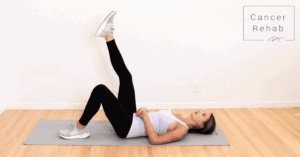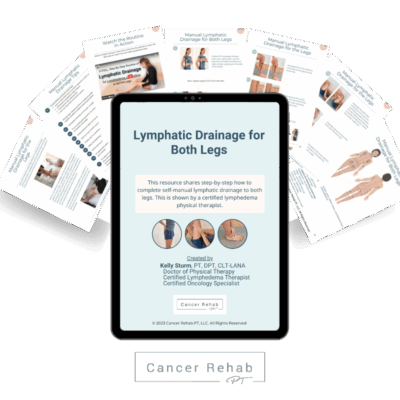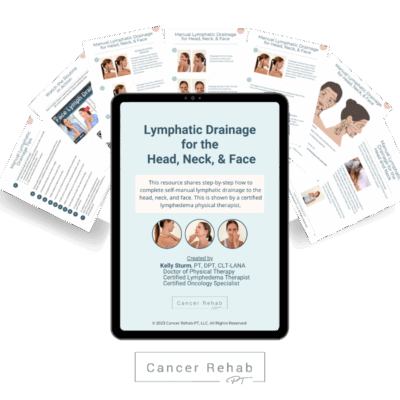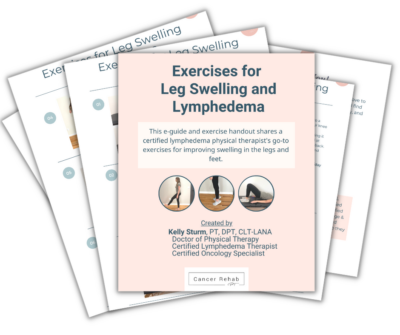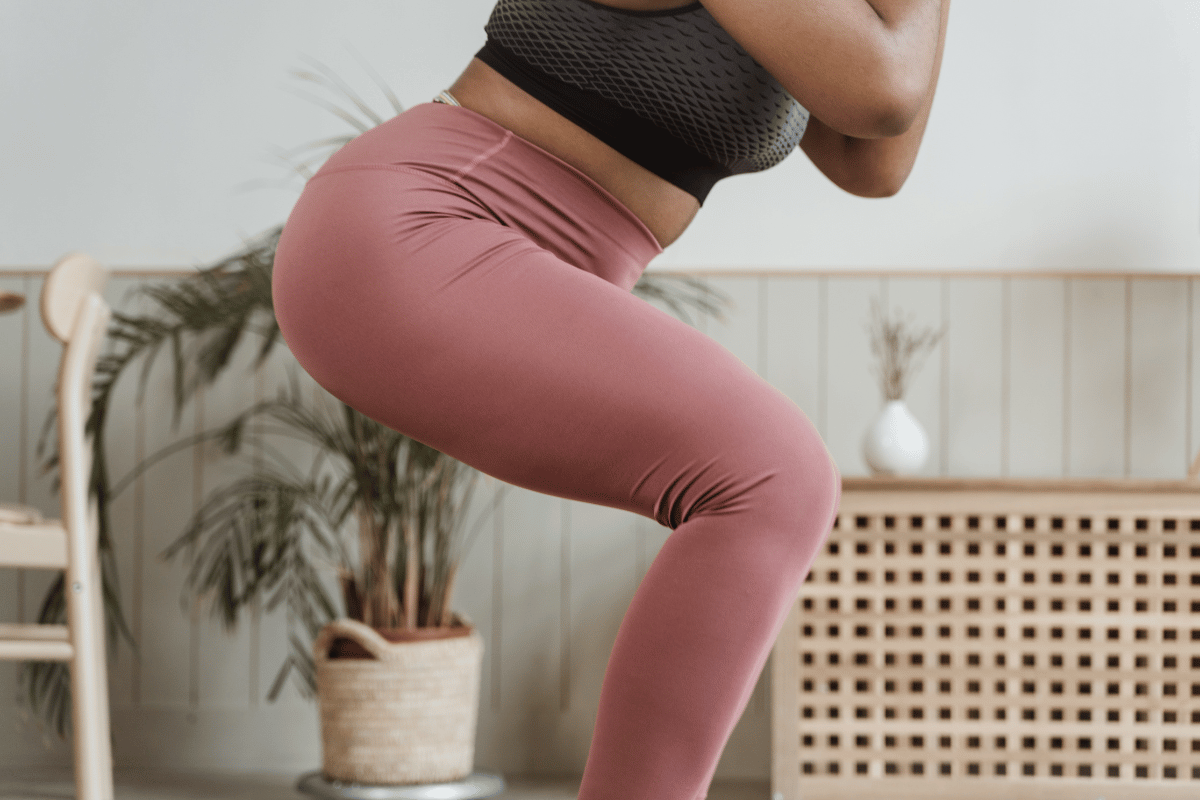Lymphedema is a chronic condition characterized by an accumulation of excess fluid in the body, most commonly in your arm or leg.
It causes swelling and can significantly impact your quality of life with physical discomfort and emotional distress. Proper lymphedema treatment can help you alleviate symptoms and, in some cases, even naturally reverse the swelling.
As a Certified Lymphedema Therapist, I often see people who accept uncomfortable symptoms as a part of living with lymphedema. The truth is, you don’t have to assume that living with constant swelling and limitations is now your new normal.
In this article, I’m going to discuss the available treatment options so you can minimize lymphedema symptoms and maximize your life. I also share in-depth resources in my programs Lower Body Lymphedema Rehab and Breast Cancer Rehab!
What Is Lymphedema?
Lymphedema occurs when the lymphatic system, which plays a crucial role in maintaining fluid balance and immune function, is not working properly.
The lymphatic system consists of a network of lymph vessels and lymph nodes that transport lymph fluid, which contains white blood cells, proteins, and waste products, from the tissues back to the bloodstream. When this system is disrupted, lymph fluid accumulates in the tissues, causing swelling and other related symptoms in the affected arm or leg.
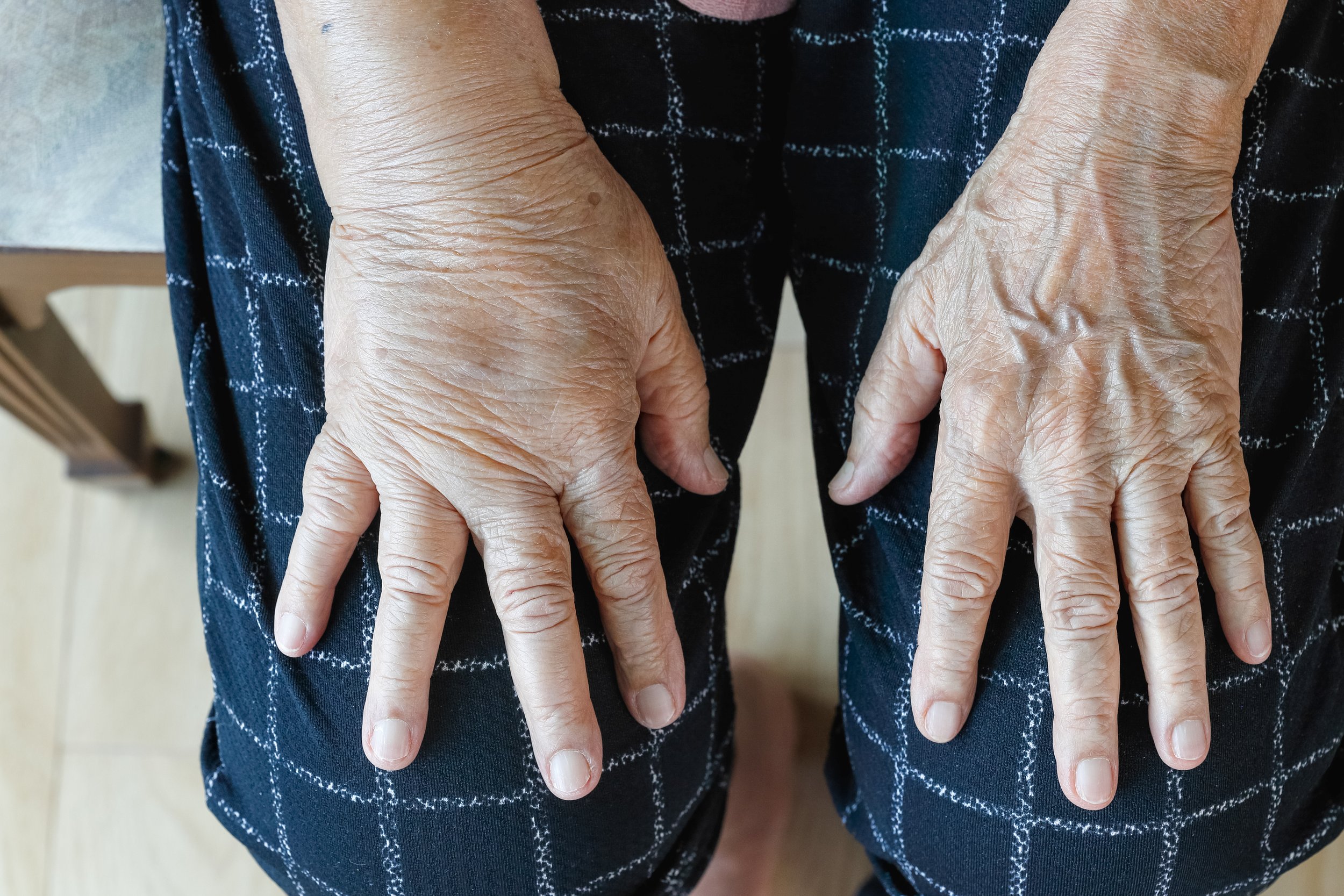
Types of Lymphedema
There are two primary types of lymphedema: primary and secondary.
- Primary Lymphedema: This form is rare and is usually inherited. It can present at birth or develop later in life, often during puberty or pregnancy. Primary lymphedema is caused by abnormalities in the lymph system, such as missing or poorly functioning lymph vessels.
- Secondary Lymphedema: This is more common and occurs due to damage or obstruction in the lymphatic system. Causes include surgery, cancer treatment, infections, and trauma.
Lymphedema is very common. According to the Lymphatic Education and Research Network1, it affects up to 250 million people worldwide. That’s more than HIV, Parkinson’s, multiple sclerosis, muscular dystrophy, and ALS combined.
Despite so many people developing lymphedema, many of them don’t have access to comprehensive education and resources to reduce the disease’s signs and symptoms. I created my program Lower Body Lymphedema Rehab to make lymphedema management available to more people.
Causes of Lymphedema
Secondary lymphedema can have various causes. Here are some of the most common ones:
- Cancer Treatments: Surgical removal of lymph nodes and radiation therapy can damage the lymphatic system, leading to secondary lymphedema. This is especially common in breast cancer patients who undergo mastectomy and lymph node dissection. Learn more about lymphedema after breast cancer.
- Infections: Bacterial or fungal infections can cause lymphatic damage, leading to lymphedema. Parasitic infections such as filariasis are a leading cause of lymphedema in tropical regions.
- Trauma: Injuries that damage the lymphatic vessels and healthy lymph nodes, such as severe burns, can result in lymphedema.
- Surgical Procedures: Surgeries involving lymph node removal or lymphatic vessel damage can result in lymphedema.
- Chronic Venous Insufficiency: When veins in the legs do not function properly, it can lead to increased pressure in the lymphatic system and lymphedema.
- Obesity: Excessive body weight puts additional pressure on the lymph system, increasing the risk of developing lymphedema.
For primary lymphedema, genetic mutations and developmental disorders typically trigger the development of the condition. Primary lymphedema is very rare, only affecting 1 in 100,000 people2.
Symptoms of Lymphedema
Lymphedema symptoms vary in severity and often impact daily activities. The earlier you start lymphedema treatment, the easier it is to manage lymphedema and reduce swelling.
- Swelling: The primary symptom, swelling typically occurs in the arm or leg but can affect other body parts. It can be mild initially and progress over time in the case of untreated lymphedema.
- Heaviness or Tightness: Affected limbs may feel heavy, tight, or full, leading to discomfort and difficulty with movement.
- Skin Changes: The skin over the swollen area may become thickened, hardened, or develop a leathery texture. It may also be more susceptible to infections and wounds as lymphedema progresses.
- Pain or Discomfort: Some people experience pain, aching, or tenderness in the affected area.
- Restricted Range of Motion: Swelling and skin changes can reduce flexibility and range of motion in the affected limb.
- Recurring Infections: The affected area may be prone to infections like cellulitis, which can further damage the lymphatic system and worsen lymphedema. If you treat lymphedema, you can reduce the risk of infections.
If you notice any of the lymphedema symptoms after cancer surgery, radiation therapy, infection, or surgical treatment, get in touch with your medical team.
Early-stage lymphedema is easier to manage and, with proper treatment, the swelling can sometimes even be reversed. Severe lymphedema is harder to keep under control. Try to get effective lymphedema treatment as early as possible!
Diagnosing Lymphedema
To diagnose lymphedema, your medical provider will do a physical examination to look for swelling, skin changes, and other symptoms. They will also assess your medical history for previous surgeries, radiation treatments, infections, and injuries that may have caused you to develop lymphedema.
You may also have to do non-invasive imaging tests such as ultrasound to visualize your lymphatic system and detect blockages or abnormalities or MRI and CT scans.
Lymphedema Treatment Options
Complete Decongestive Therapy (CDT)
Complete Decongestive Therapy, or CDT, is the gold standard for lymphedema treatment. It typically includes the following elements:
- Manual Lymphatic Drainage (MLD): A specialized massage technique that stimulates lymphatic flow, encouraging trapped fluid to move away from the swollen limb.
- Compression Therapy: Wearing short-stretch bandages or the use of compression garments, such as sleeves or stockings, to apply pressure and prevent fluid buildup.
- Exercise: Specific physical therapy exercises to improve your lymphatic flow and muscle activity, reduce swelling, and maintain mobility.
- Skin Care: Proper skin care to prevent infections and complications by keeping your skin clean, moisturized, and free from injuries.
Complete Decongestive Therapy is a noninvasive approach that consists of two phases. The first phase lasts 2-6 weeks, and its goal is to reduce the volume of the swelling in the affected area. Once the swelling is reduced, phase two continues long-term to maintain the results, keep your fluid moving, and prevent lymphedema from getting worse.
Physical Therapy and Exercise
Physical exercise is an effective way to manage lymphedema symptoms. Movement helps lymph fluid circulate because your muscles act as a pump to the lymphatic system. When you contract and stretch them, you move lymph fluid out of the swollen areas and support your immune system.
Focus on low-impact physical exercises such as walking, swimming, biking, and yoga. If you’re looking for a place to start, I also have a playlist of lymphedema exercises on YouTube.
If you have access to a physical therapist, they can help you create a personalized exercise program. All kinds of movement are helpful, but the best type of exercise for lymphedema is an exercise that you like and can stay consistent with!
Compression Therapy
Compression therapy is a lymphedema treatment that involves wearing short-stretch compression bandages or special garments that apply consistent pressure to the affected arm or leg. This helps to reduce swelling and promote lymphatic flow. Compression therapy can also help prevent infections and other complications because it minimizes skin changes and protects your skin.
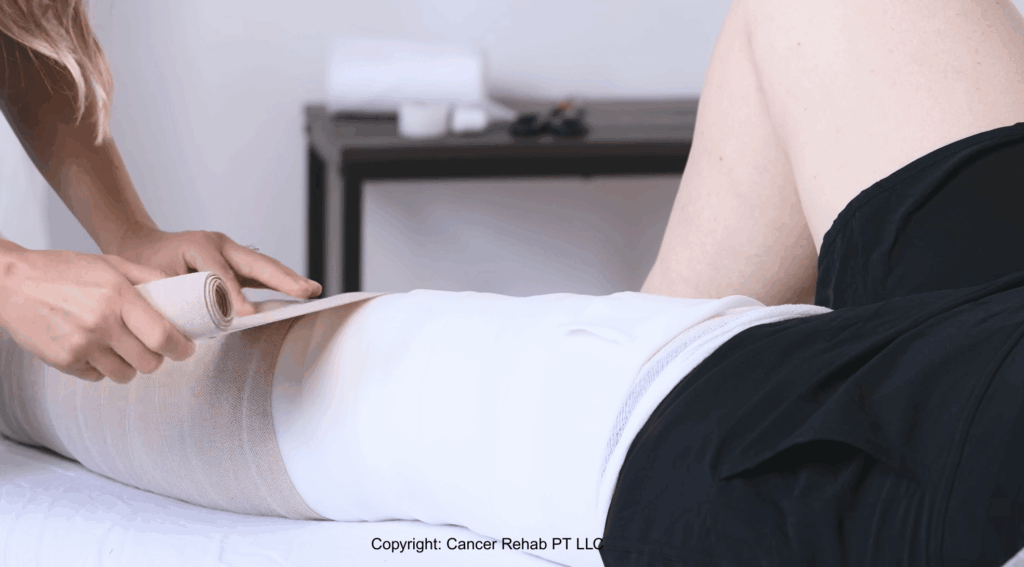
Compression bandages are applied over foams and paddings to help reduce fluid volume. As a lymphedema therapist, I find it important to work with a specialist for individualized techniques if someone has any lobules or skin sensitivities. Once someone has reduced in volume as much as possible, then we transition to them to a compression garment for maintenance.
It’s important to choose compression garments that fit properly.
Wearing compression garments incorrectly can actually make lymphedema worse. Choosing the right lymphedema garments can be overwhelming because there are many options out there, so take a look at some of my favorite products to narrow down your choices.
Manual Lymphatic Drainage
Manual lymph drainage massage is a gentle and rhythmic massage technique that stimulates your lymphatic system and improves the movement of lymph fluid out of the swollen areas. You can see a certified lymphedema therapist to get a lymphatic drainage massage or learn how to do it at home.
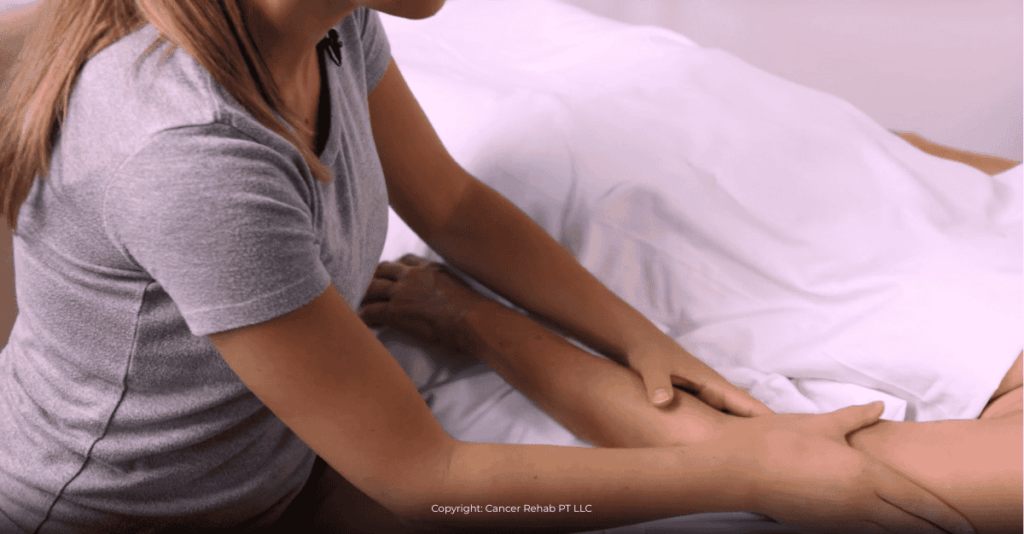
Pneumatic Compression Devices
Pneumatic compression devices are mechanical pumps that apply controlled pressure to the affected area. These devices can help reduce swelling and other lymphedema signs by promoting lymph fluid movement.
Lymphedema Surgery
Complete Decongestive Therapy is the main form of lymphedema treatment. It effectively reduces swelling at various stages of lymphedema. However, in some cases, different types of surgeries can be considered to treat lymphedema. Lymphedema surgery is not as widely practiced as CDT, but there are growing opportunities in the field.
Microsurgical vascularized lymph node transfer, lymphatic bypass surgery, and liposuction can all potentially be used to treat lymphedema.
However, it’s important to note that in many cases, compression therapy, physical exercise, manual lymph drainage, and other noninvasive approaches are enough to effectively treat lymphedema and, in some cases, even reverse the swelling.
The Importance of Lymphedema Self-Care
Lymphedema is a chronic condition with no known cure. Lymphedema treatment is an effective way to minimize symptoms and, in some cases, even reverse swelling, but it’s essential to create a supportive lymphedema self-care routine to maintain your positive results.
Regular physical exercise, staying at a healthy weight, wearing compression garments, and practicing good skin care should all be a part of your at-home lymphedema management routine.
It’s also important to be aware of the things that may cause a lymphedema flare-up. Common triggers include infections, physical trauma or injury, standing or sitting down for long periods, and extreme heat or cold. Everyone is unique, and there may be other factors that cause lymphedema flare-ups for you, so stay conscious of your triggers!
FAQs
How Do I Get Rid of Lymphedema in My Legs?
Leg lymphedema can be really uncomfortable, but there are ways to minimize your symptoms and reduce swelling. Complete Decongestive Therapy (CDT), wearing compression bandages and garments, and regular physical exercise can all help you manage lymphedema symptoms.
That said, lymphedema is, unfortunately, a chronic condition with no known cure. You may never be able to completely get rid of lymphedema in your legs, but effective lymphedema treatment will significantly improve your quality of life.
Does Lymphedema Ever Go Away?
Lymphedema is a chronic condition, meaning it does not go away completely. However, it can be effectively managed with appropriate lymphedema treatment and self-care strategies.
Although there is currently no cure for lymphedema, various therapies such as complete decongestive therapy (CDT), compression garments, manual lymphatic drainage, and regular exercise can significantly reduce symptoms and improve quality of life. Consistent management is essential to control swelling, prevent complications, and maintain limb function.
What Should You Not Do with Lymphedema?
If you have lymphedema, you should avoid activities that can cause trauma or injury to your affected arm or leg because even minor cuts or scratches can lead to infections and worsen swelling. Standing or sitting down for long periods of time without taking a break can impair your lymphatic flow.
You should also avoid wearing constrictive clothing or jewelry. This may sound confusing because wearing compression garments can be a part of your lymphedema treatment. However, it’s important to know that medical professionals and specialized lymphedema therapists designed compression garments to support your lymphatic system. This is not the case for regular clothing and accessories.
How Do You Reverse Lymphedema Naturally?
Lymphedema is a chronic condition, but in some cases of early-stage lymphedema, it may be possible to reverse the swelling. Regular low-impact exercise and Complete Decongestive Therapy can effectively stimulate lymphatic flow and reduce swelling. Most importantly, reversing lymphedema naturally requires you to be proactive. The earlier you start managing your lymphedema symptoms, the higher your chances of reversing the swelling. Get started with Lower Body Lymphedema Rehab.
How Much Does Lymphedema Treatment Cost?
The cost of lymphedema treatment depends on many factors, such as your location, treatment methods, insurance coverage, healthcare provider fees, and more. As a Certified Lymphedema Therapist, I know that high-quality lymphedema care is not accessible to everyone. This is why I created Lower Body Lymphedema Rehab and Breast Cancer Rehab (for lymphedema after breast cancer treatment). These online, self-paced resources are full of exercises and tools to help you reduce lymphedema symptoms.
What Is the Most Effective Treatment for Lymphedema?
There are many forms of effective treatment for lymphedema, such as Complete Decongestive Therapy and physical exercise. That said, the most effective treatment for lymphedema is the one you can stick with long-term. Lymphedema is a chronic condition, so it’s important to develop an accessible self-care routine that fits into your life. Even small steps can make a big difference.
Get Support in Lower Body Lymphedema Rehab
Lower Body Lymphedema Rehab is my in-depth online program where I educate you on lymphedema treatment techniques that I regularly use with my clients as a Certified Lymphedema Therapist. Learn more about the program!



